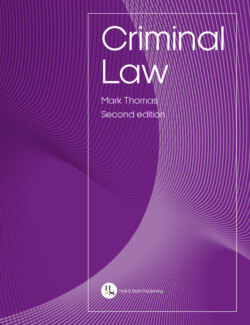Читать книгу Criminal Law - Mark Thomas - Страница 71
На сайте Литреса книга снята с продажи.
2.4.2.1Distinguishing positive acts from voluntary conduct
ОглавлениеAt 2.4, it was made clear that one must distinguish positive acts from voluntary conduct. Although the two concepts go hand-in-hand, they must be considered separately to account for their position in the criminal law.
To help with this idea, consider the case of R v Savage; DPP v Parmenter [1991] 3 WLR 914 (particularly, the facts of R v Savage).
case example
Charge: Inflicting GBH (OAPA 1861, s 20)
Case progression: Crown Court –Guilty
Court of Appeal – Appeal allowed but replaced with charge of ABH
House of Lords – Conviction upheld
Point of law: Requirement of mens rea to cause ABH
In R v Savage; DPP v Parmenter [1991] 3 WLR 914, the defendant threw a glass of beer over her husband’s ex-girlfriend. The glass slipped from the defendant’s hand and resulted in cuts to the wrist of the victim when the glass smashed. The defendant professed that she never intended to throw the glass; she merely intended to humiliate the victim by throwing the beer. The defendant was convicted of inflicting GBH in the Crown Court.
On appeal, the House of Lords was faced with the question as to whether the defendant was required to intend to throw the glass in order to be liable.
Lord Ackner reasoned that:
the physical harm which the defendant intended or foresaw might result to some person need only be of a minor character for him to be guilty and it is unnecessary for the Crown to show that he intended or foresaw that his unlawful act might cause physical harm of the gravity described in s 20, ie either wounding or grievous bodily harm.
We shall return to this question in a later chapter, but, for present purposes, this case demonstrates, inter alia, that the defendant positively threw the glass at the victim but the act itself was not voluntary given that the glass, allegedly, slipped from her hand. Intention or foreseeability is not the question at this stage; rather, we are simply concerned with whether her act was voluntary. Another useful example of this can be seen in R v Malcherek; R v Steel [1981] 2 All ER 422 in relation to the switching off of a life support machine. This is a voluntary act, but is it a positive act? This is considered below.
In general, an act must be both voluntary and positive, although, as we shall see below, a positive act is not required in all circumstances and a failure to act may be sufficient.
